Butterflies and Moths
Media
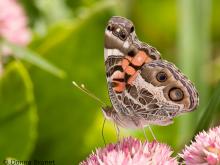
Species Types
Scientific Name
Vanessa virginiensis
Description
The American lady resembles the closely related painted lady butterfly. It has two large spots on the hindwing underside, however.
Media

Species Types
Scientific Name
Speyeria idalia
Description
The regal fritillary is a large, silver-spotted, orange and blackish-gray butterfly of our native tallgrass prairies. Because of its dwindling habitat and steeply declining numbers, it is a species of conservation concern in Missouri and nationally.
Media
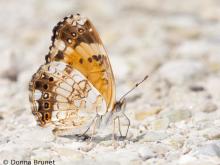
Species Types
Scientific Name
Chlosyne nycteis
Description
Black and orange above, paler below, the silvery checkerspot has a telltale wide white crescent in a brownish patch along the edge of the hindwing underside.
Media
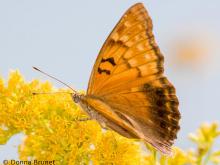
Species Types
Scientific Name
Asterocampa clyton
Description
The tawny emperor is less common than the hackberry emperor and has a rustier coloration. Both species feed on hackberry trees as caterpillars.
Media
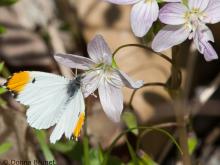
Species Types
Scientific Name
Anthocharis midea
Description
Falcate orangetip males are unmistakable with their small size, white coloration, and orange wingtips. Look for them in open woodlands in April.
Media
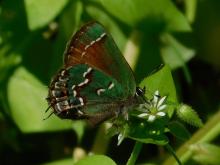
Species Types
Scientific Name
Callophrys gryneus gryneus (syn. Mitoura gryneus gryneus)
Description
The only green butterfly in Missouri, the olive (or juniper) hairstreak never strays far from eastern red cedar, its larval food plant. Adults fly between April and August.
Media
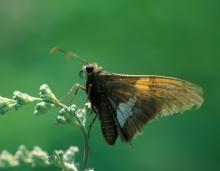
Species Types
Scientific Name
Epargyreus clarus
Description
In a large, global family of several thousand species, the silver-spotted skipper is one of the easiest to identify in our state.
Media

Species Types
Scientific Name
Hylephila phyleus
Description
Fiery skippers have plain orange undersides scattered with a sprinkling of small dark spots. Males have flame-shaped orange patches on the hindwing upper surface.
Media
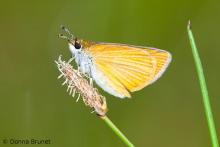
Species Types
Scientific Name
Ancyloxypha numitor
Description
One of the smallest skippers in the eastern United States, the least skipper is found in moist, grassy areas, usually near water.
Media

Species Types
Scientific Name
Polites peckius
Description
Peck’s skipper is found in Missouri’s fields, lawns, and other open habitats from May through October. Identify it by the one yellow hindwing rectangle that is wider than the others.
See Also


Media

Species Types
Scientific Name
About 1,500 species in North America north of Mexico
Description
Adult caddisflies are mothlike. Their larvae are aquatic and build portable, protective cases out of local materials, including grains of sand, bits of leaves and twigs, and other debris.
Media

Species Types
Scientific Name
Corydalus cornutus
Description
Adult eastern dobsonflies are huge and mothlike, with large wings and a weak, fluttery flight. The fiercely predaceous aquatic larvae, called hellgrammites, are well-known to anglers, who often use them as bait.
About Butterflies and Moths in Missouri
Butterflies, skippers, and moths belong to an insect order called the Lepidoptera — the "scale-winged" insects. These living jewels have tiny, overlapping scales that cover their wings like shingles. The scales, whether muted or colorful, seem dusty if they rub off on your fingers. Many butterflies and moths are associated with particular types of food plants, which their caterpillars must eat in order to survive.





















